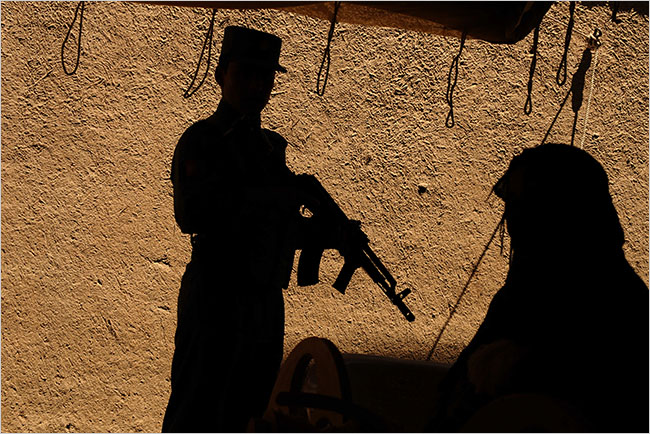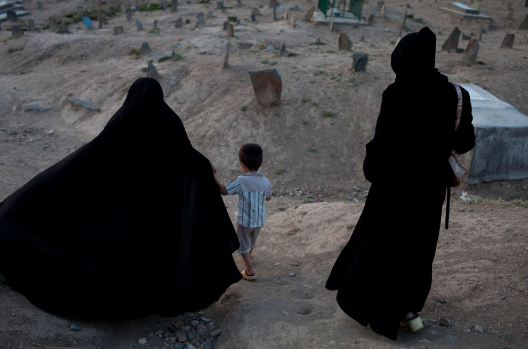Photographs can show us not only what was in front of the camera but also ways of seeing. Two recent photos from Afghanistan each present a scene and at least two different perspectives on what is seen. Although not representative of all the images being taken there, they can illustrate a dilemma confounding attempts to understand that distant country.

The caption at the New York Times stated that “An Afghan police officer stood guard Thursday in Kabul during a campaign stop by Ashraf Ghani, a presidential candidate.” But is it the policeman or his silhouette? Are we seeing his shadow cast on a wall, or is it him with everything but his outline obscured by the intense contrast between darkness and light? One can’t be sure whether we are seeing reality or a mirage.
This illegibility that comes from casting the Afghanis in darkness can be taken in at least two ways. We may be seeing the continuing projection, as if a movie on the wall, of a colonial world. The local (client) militia are there in our stead, complete with colonial cap and weapons supplied by the West, but they remain shadows rather than people, much less a force to be reckoned with. Dark, ephermeral, and mere cutouts of the Western military they are imitating, they represent only the outline of civilization against a barren backdrop close to the state of nature. Their culture is likewise located in darkness, signified here only by the enigmatic figure in traditional garb on the right–is he being guarded or merely a spectator? Mystery and danger are mingled together in the darkness that hides those who, for whatever reason, avoid the light–and enlightenment.
The darkness will be cooler than the sun-blasted street, however, and the photographer could be showing us not only what was there but also how little we can know about it at a glance. (The image will have been selected for its visual distinctiveness, of course, but that doesn’t solve the interpretive problem.) In fact, the silhouettes (whether actual or apparent) present a more accurate corollary to the caption: we are seeing exactly that–an officer standing guard–and nothing more. For the rest, you have to not only see more but know more. Stated otherwise, you know almost nothing about “Ashraf Ghani, a presidential candidate” from this photo, or about anything else of the event it depicts. Thus, the photograph does the neat trick of not only documenting what is there–which may include traces of colonial relationships still present today–but also highlighting our ignorance about what we are seeing.
In sum, the photograph presents one scene but two mentalities: Someone can see it through the lens of orientalism, where the exotic other is not quite real and so a blend of fact and fiction, mystery and danger, an object of fear or desire but never an equal; or one can see it with an awareness of the ignorance that comes from not being there, not knowing the language, and having to depend on this small fragment of an image to add to what meager knowledge we might have. Nor does one have to choose which interpretation is most real–that would be like trying to determine whether one is seeing a person or his silhouette. And, of course, if you have to ask. . . .
With that tension in mind, take a look at this photograph:

The Times caption identifies these figures as Afghans at a cemetary in Kabul. And so they are. And, as above, the adults (those wholly socialized into their culture) are black figures, unidentifiable save as types. Like the seated figure above, they have their backs to the viewer. Are they shrouded in their culture and still oriented toward the past, or are we being reminded of how little we know about this place and the people who love, grieve, live, and die there?
Photographs by Tyler Hicks/New York Times and Massoud Hossaini/Agence France-Presse—Getty Images.
A really great short Essay about that kind of topic! A good starting-point for such thoughts is also the Theory of Visual Anthropology – there you can find a lot about seeing, interpretation and thus the problems of information, photography and knowledge….
Hope to read more in the future at this great site about that topic!
Greetings from Hamburg/Germany
Benjamin Hiller